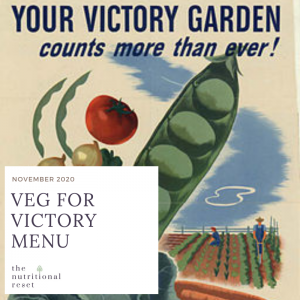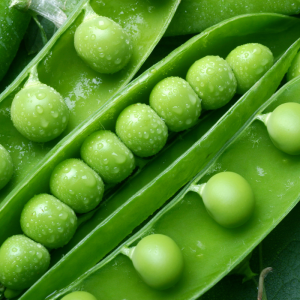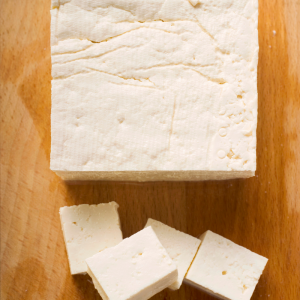 November is the month we remember those who fought and died to preserve our freedom. In their honour, this month’s menu harkens back to the Victory Garden or War Garden. Folks were encouraged to grow their own food to allay shortages and support the war effort. More produce grown in front yards meant more transport freed up to move food, soldiers and munitions to Canada’s allies overseas. A secondary benefit was how victory gardening boosted morale and brought communities together.
November is the month we remember those who fought and died to preserve our freedom. In their honour, this month’s menu harkens back to the Victory Garden or War Garden. Folks were encouraged to grow their own food to allay shortages and support the war effort. More produce grown in front yards meant more transport freed up to move food, soldiers and munitions to Canada’s allies overseas. A secondary benefit was how victory gardening boosted morale and brought communities together.
Traditional victory gardens included very nutrient-dense foods, such as the beans, peas and kale found in this menu, as well as Swiss chard, cabbage, squash and root veggies like beets, carrots and turnips that store well for winter consumption. Homeowners also kept hens for their eggs. And the U.S. Food Administration’s first campaign in WWI encouraged citizens to participate in Meatless Tuesdays and Wheatless Wednesdays in order to reserve more of these foods for the troops. So this menu is meatless and wheatless as well.
The title of the menu, Veg for Victory, has a double entendre. Because eating more whole, nutrient-dense plant foods is a winning strategy when it comes to coronavirus. Vegetables are full of anti-inflammatory and immune-supportive compounds. And filling up with veggies, rather than starchy carbs and highly processed foods, will keep you at a healthier weight with lower risk of COVID-complications.
I’m not suggesting you should grow your own food, only that you eat more vegetables and fruits. Aim high! Go for 6 to 8 servings of veggies and 2 servings of fruit per day (half your plate). But if you “dig” your own victory garden, now’s the time to start your research for spring. Here’s one small plot victory garden design to seed your creativity.
The triple entendre of the title is the slang meaning of the word veg, as in to while away your time at home rather than being out and about. Right now, consider it your patriotic duty to veg. Socializing only with members of your household and limiting all but essential activities is another way we will win victory over coronavirus. Perhaps you can use some of your “found time” to try these these meatless and wheatless victory garden inspired recipes. I hope you enjoy them!
Sign up here to receive the recipes from the Veg for Victory Menu.
Veg for Victory Menu
Breakfast: Breakfast Tacos with Mashed Peas & Edamame (a verdant, veggie- packed take on breakfast…start your day sunny side up!)
Lunch: Kale, Lentil & Sweet Potato Salad (this salad ticks all boxes for winter: warm, comforting and full of flavour)
Dinner: One Pan Paprika Tofu & Veggies (I love the simplicity of one pan dinners; you can make this with tempeh if you prefer the nuttier flavour of fermented soybeans)
Join The Nutritional Reset community here to receive this month’s menu today (as well as each month to come)!
A few featured foods …
 Peas
Peas
Green peas are a great source of both vitamin K and manganese to help keep your bones strong. They boost folate which is vital for heart health. And they provide a significant amount of immune-supporting vitamin C. I also like that they are relatively high in protein as far as veggies go. So they keep you feeling full for longer. Best yet, you can buy them frozen so you always have a veg on hand either as a side (boil with fresh mint) or add them to soups, stews, curries, quinoa or rice.
 Tofu
Tofu
Yes, tofu really was on the menu in North America around WWI (of course, Asians had been eating it for centuries). During WWI, the U.S. Department of Agriculture Bureau of Chemistry began looking for “meritorious substitutes” for foods made scarce by trade disruptions and hungry armies. One lab directed by Dr. Yamei Kin (in 1885 she was the first Chinese woman to earn a U.S. medical degree and rather a celebrity) promoted tofu as a meat substitute.
A Chinese proverb refers to tofu as “the meat without bones”. This is because soy, which is used to make tofu, is one of only two plants that are complete proteins containing all nine essential amino acids that must come from food because the body cannot make them (the other is quinoa). Tofu is quite versatile and takes on the flavours of whatever you cook it with. And it is very nutrient dense for a low-calorie food as well as a lower carb source of plant protein than beans or lentils. The brine used in the coagulation process determines the mineral content, making it rich in either calcium or magnesium. All tofu is high in iron. Keep in mind that 90% of soy crops are genetically modified and heavily sprayed with pesticides, so always purchase organic tofu. And, like all foods, minimally processed is best.
Cooking your own food is the single most impactful step you can take to improve your health and energy!
I hope you enjoy the recipes in my Veg for Victory Menu. Sign up here to receive the download link for this latest Menu of the Month. And if you want to cook more of your own food but don’t know what to make or have the time to organize your own menus and shopping lists, The Nutritional Reset offers a meal planning service. It makes preparing tasty, nutritious meals a snap. Click here to find out more.